River crossings are the main challenge of Icelandic F-roads. If it wasn’t for them, 95% of F-roads would be easy to pass. However, they do exist and create a significant obstacle. Improper river crossings may cause huge and expensive damages to your car. In extreme situations, even your life may be at stake. That being said – prepare thoroughly for your river crossings! Here is a detailed guide on how to cross a river in Iceland.
With river crossings, it all comes down to HOW, WHERE and WITH WHAT.
By HOW I mean general rules for a safe river fording. It’s essential to adhere to them, no matter how big your car is.
By WHERE I mean where are you crossing. What is the type of river? How big is it? What is the season? How much did it rain recently?
By WITH WHAT I mean the type of vehicle you are operating. Generally said, the bigger the better – but it’s more complicated.
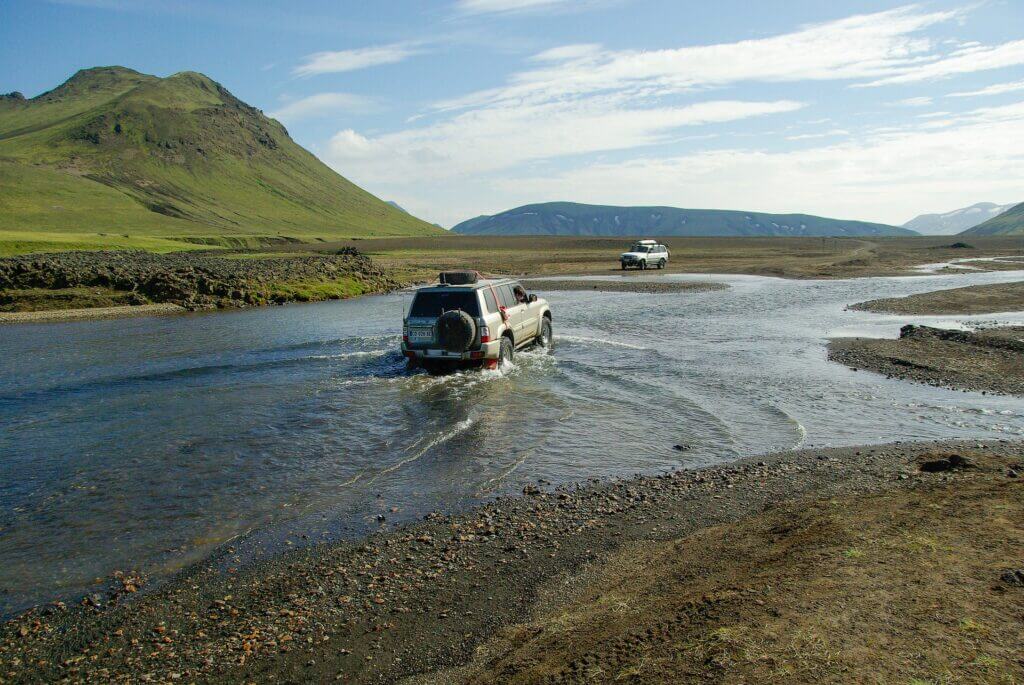
How to safely cross Icelandic rivers? (HOW)
- Make a plan. Do you have a proper car? What types of rivers are in your way? Are you equipped sufficiently? Think before.
- Check by searching for the road
- Check by searching for the place
- Check by searching for the area
- Check the road conditions. If they say impassable, don’t even try it yourself. Isak 4×4 can help you with their Convoy driver or sit-in guide. If they say passable, read further. What does it mean passable, impassable, and no winter service? Here is the explanation of Icelandic road states.
- Examine the river.
- So you arrived at the river. If you can see with your eyes that it’s a small river or even just a pond, you may usually proceed with passing. What’s a small river? Read below in “WHERE“.
- If you can’t assess the depth with your eyes, find out physically. Go into the river. How are you supposed to do that in ice-cold water? Get inspired by how we’ve done it.
- Alternatively, wait for someone else (ideally with a similar car) to pass.
- Compare the river to your car. The essential thing is, whether your air intake is high enough above the water level. But that’s not the only thing. See below in “WITH WHAT“.
- Stay inside yellow markers. Those mark the area allowed for crossing (and usually also shallowest). They are situated on the borders of a passable area.
- Go for the shallowest part.
- If it’s a medium-sized or even a bigger river, it’s really important to cross it through the shallowest part. This is usually NOT the exact middle of the river crossing, but rather its sides.
- This is usually NOT where the river is calm – that’s typically the deep part. Better find a part where you can see the stream of river running into pebbles and cross on that pebbles.
- Turn 4×4 mode on.
- Drive slowly.
- First, max second gear, around 10kph to create a little “wave” around your car. Ride that wave.
- If you drive too quickly, water will splash into your engine and your car may be dead. See below in “WITH WHAT“.
- Don’t stop. Don’t switch gears. If you do, you may not get the car going again. Don’t get scared by your car shaking inside the river, just go steady.
- Down the stream. If it’s possible, go with the stream, not against it. This will lower the chances the water will get into your engine.
- Stay near the rope. Sometimes there’s a rope in the river. It’s not there by coincidence. Rangers installed it there typically to indicate the shallowest part. Drive near the rope, this should be the best spot to cross the river.
Don’t want to fear paying for your drowned car? Use Lotus! Now with our 5% discount.
What types of river crossings are in Iceland? (WHERE)
The basic categorization can be made according to the depth of the river crossing.
- PONDS
- Up to 20cm / 8 inches.
- If the depth of a river crossing is this shallow, you don’t have to bother much about crossing at all. It’s doable with any car, even with a 2wd one.
- SMALL
- 20 to 40cm / 8-16 inches.
- Here some ground clearance of your car starts to make sense. I consider 40cm to be still a small river but it’s already a non-trivial crossing. If you do it wrong, you may end up like this.
- MEDIUM
- 40 to 70cm / 16 to 28 inches.
- This is already some decent river crossing. You will probably not get drowned but you may waste your car easily.
- It’s still a manageable crossing though, even for beginners! You just have to adhere to river crossing rules strictly and drive a proper car.
- Examples: F208 south, F235, F224, F910
- BIG
- More than 70cm / 28 inches.
- I would avoid these at all costs if I was a river crossing beginner. Not only may you waste your car, but you could also get yourself seriously injured, if not killed.
- You need to have a combination of a) proper car, b) adhering to river crossing rules, and c) experience
- Examples: F233, F249, sometimes F26, F88, F210
The depth of the river is the single most important factor when it comes to a river crossing. There are of course several other aspects influencing your fording:
- Has it rained heavily for a few days? Add some centimeters on top of your expected river depth.
- Is it just early summer? Glacial rivers will have substantially more water compared to the late summer.
- What is the riverbed like? Is it stony or muddy? If it’s muddy, it will be harder for you to ford.
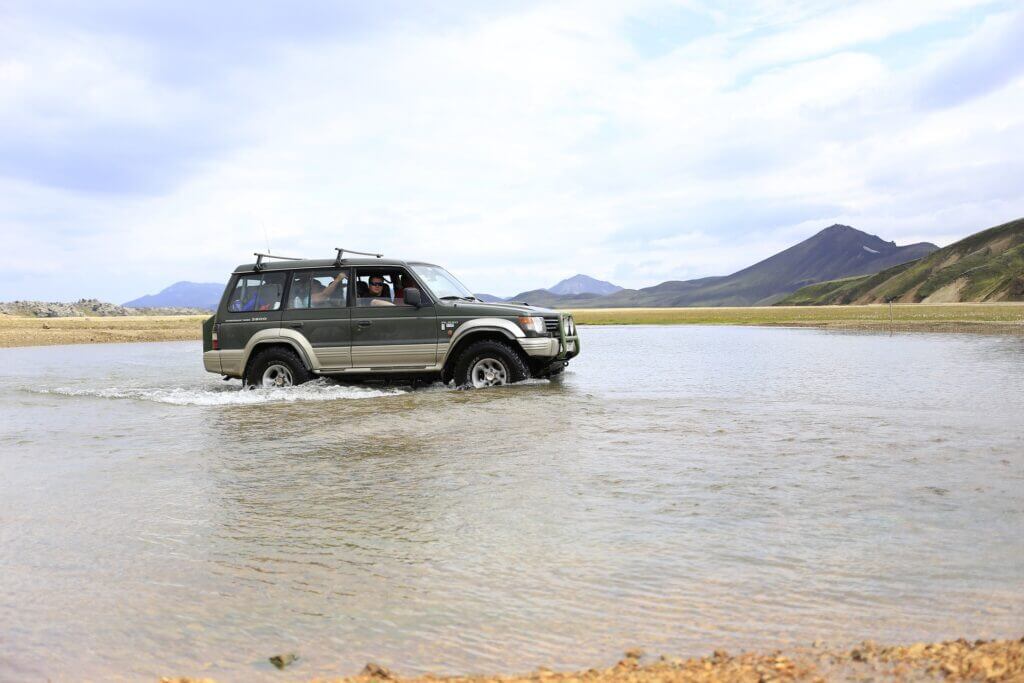
What car do I need to cross rivers? (WITH WHAT)
Ok now you know HOW to cross and WHERE will you be crossing. It’s time to get to WITH WHAT. A right car is essential. But how are you supposed to know what car is the right one? Of course, we are talking only about 4wd/4×4 now:
- The bigger the ground clearance (and wheels), the better. Because of several reasons. Firstly, your air intake will be higher (see below). Secondly, the chances you will get stuck in a river are lower. Thirdly, the chances, you will damage your undercarriage are lower.
- The higher the air intake, the better. Study this one carefully. The main risk with river crossings is flooding your engine with water (then the engine usually becomes dead). This happens once the water reaches an air intake of your car. The water level should be AT LEAST 10cm/4inch below your air intake!
- The stronger engine, the better. Inside rivers, some additional horsepower may only help. BUT – use your horsepower on the lowest/2nd lowest gear only when crossing the rivers!
- Snorkel is a plus. If your car has a snorkel installed, it basically deals with point number 2. It adds considerable height to your air intake. It’s not everything, though. You may have a snorkel, but with the too-low ground clearance, you could still get stuck in a bigger river.
When there are only PONDS in your way, you may basically choose any car.
When there are SMALL RIVERS in your way, ideally choose any SUV or 4wd car.
When there are already MEDIUM RIVERS in your way, choose your car wisely and better opt for at least a medium-sized SUV.
When there are BIG RIVERS in your way, either avoid them at all or if you really want to, then choose the super-jeep.
We also offer you FREE discount codes for several Icelandic car rental companies.
Example of the correct river crossing
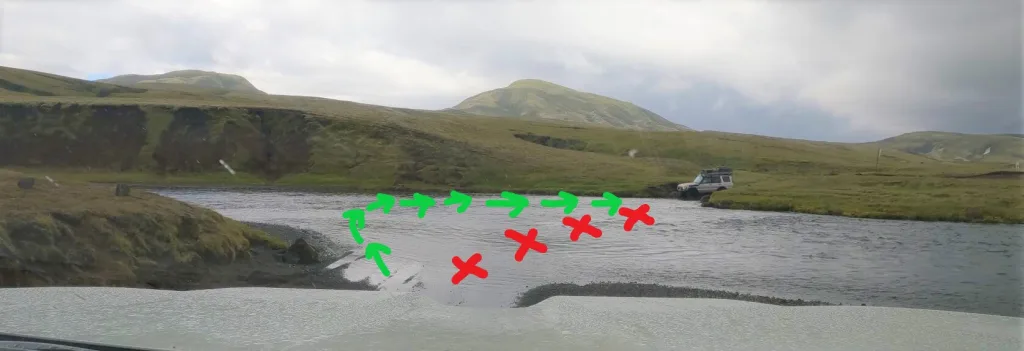
Correct river crossing of Sydri Ofaera river on F233
Every river crossing in Iceland is specific, and road F233 is a nice example of it. Syðri-Ófæra river crossing is the biggest obstacle of the notoriously known F-road Álftavatnskrókur or F233. Sydri Ofaera is typically a big river and also a very specific and unmarked river fording. The correct crossing is not obvious at first glance, but locals know it well.
The trick is, you should NOT ford straight. Rather, you have to drive in a U-shaped pattern. BUT – not to the east where the river is deep, but to the west, where it is shallow. OK, and why not go straight? Because there are huge boulders in the way that could easily stop even a super jeep.
Example of how NOT to cross the river
The video below from our friend Lucas is a nice example of how NOT to cross the river in Iceland. The driver has done nearly everything wrong:
- Drove through the deepest point (middle), instead of the shallowest parts (both sides where the ropes are)
- The river depth was too deep for Dacia Duster (in the middle), the car almost died and the driver was just lucky the engine started again.
- Blocked the road for another car, taking pictures and even being rude to them!
- Driving too fast through the second river crossing.
Below is a beautiful example of possibly the biggest mistake you should avoid when crossing rivers in Iceland. Never go fast! You will flood your engine this way. Exactly as the guy below flooded his engine. The car was dead within a second.

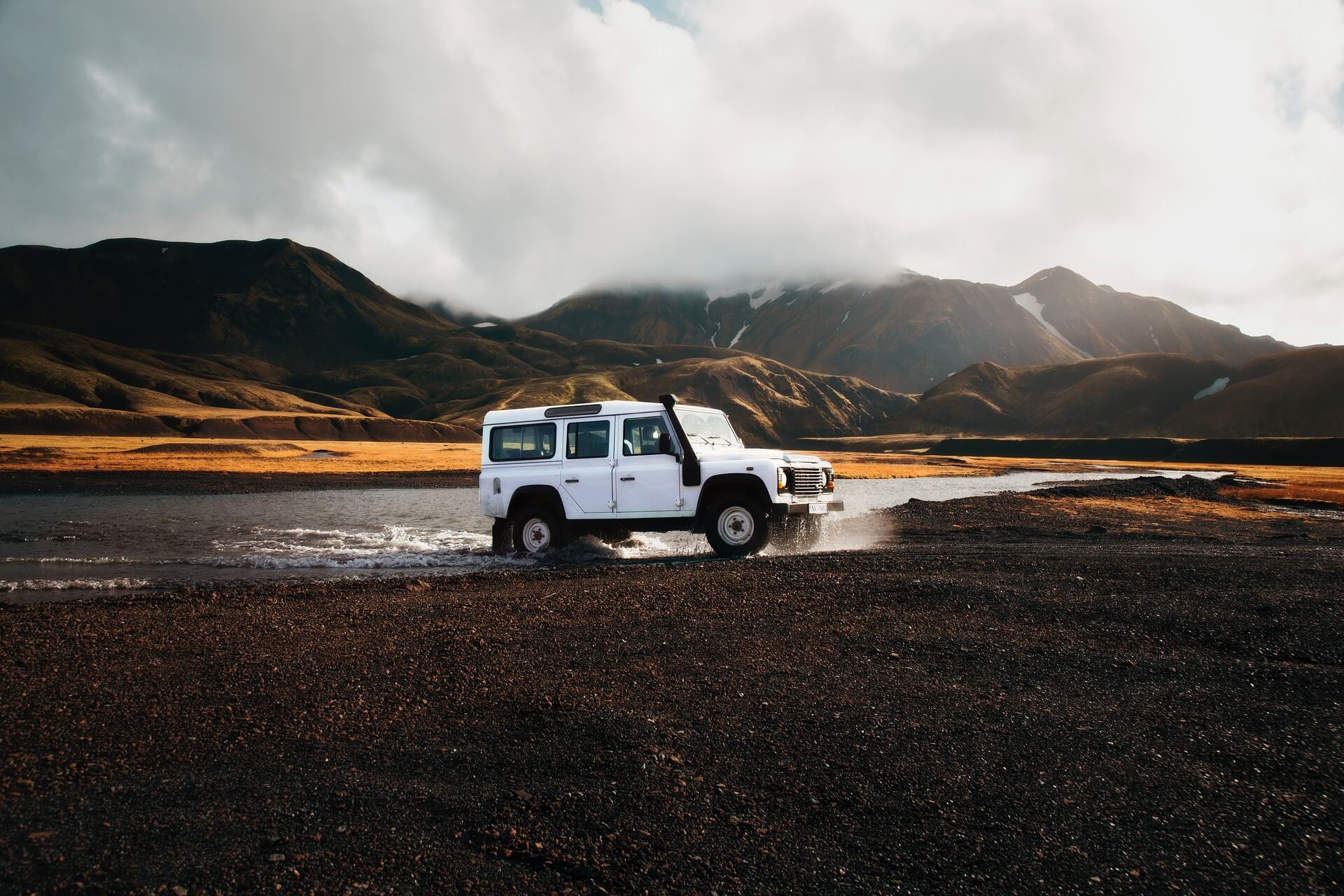
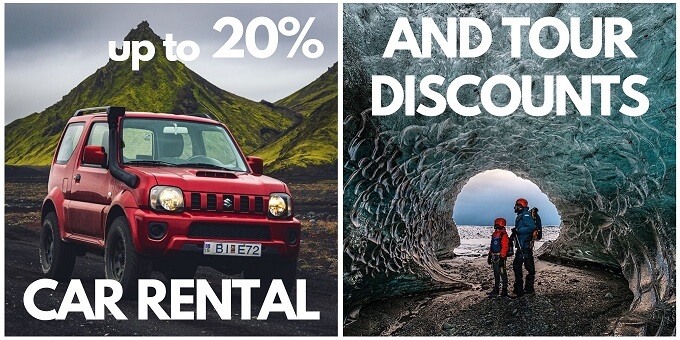
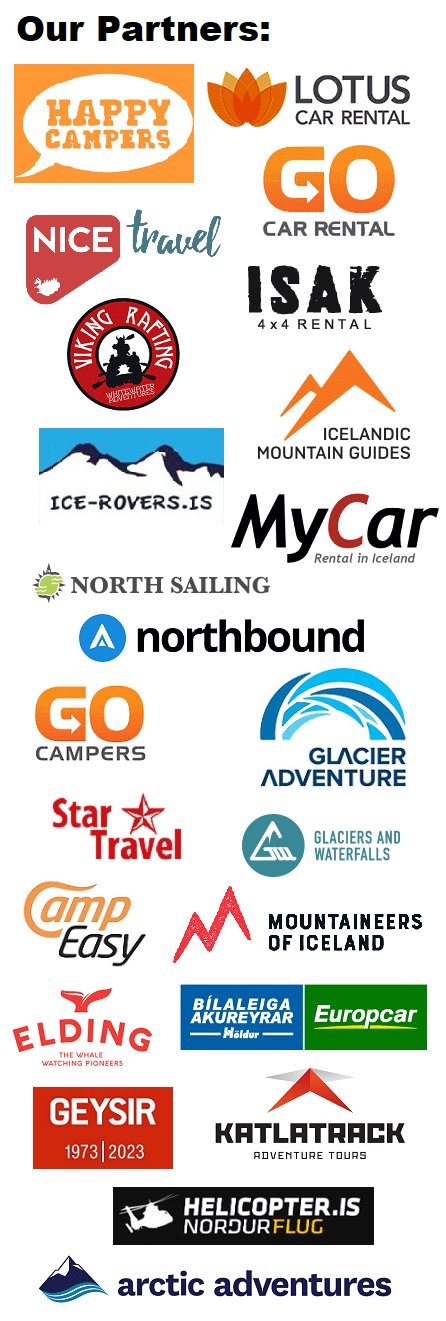

It’ll be my first time traveling to Iceland in early September and I cannot tell you what a help your site has been! I do plan on getting a 4×4 for small and medium river crossings, but wanted to ask your opinion about the road(s) leading to Thorsmork. From all I’ve read online so far it seems like you either have to rent a super-jeep or go with a guide (way too expensive)… is there any other way?? There are quite a few hikes there I wanted to check out so I would be staying overnight as close to the trailheads as possible. Thanks in advance for any advice!
Hi Galina, thank you very much for your words, they give us the energy to continue with the site 🙂
We wrote a detailed article about getting to Thorsmork here: https://epiciceland.net/detailed-guide-thorsmork-iceland/
Yes, you need at minimum a Land Cruiser to get there, sometimes even bigger car. But, you may still take the bus- and walk from Basar hut or Langidalur to all the hikes you want to do. You may also camp/rent an accommodation in this area. So you can definitely go on your own without guide and without car – by bus. It just takes more time and some planning.
Hello!
I really enjoyed your website, travelling and a detailed presentation of F-roads. I am living in Iceland and love to travel inside the country, although not Icelandic. I have done some of the described F-roads…but more to come. Regarding crossing the Sydri Ofaera river, I could suggest driving a bit further to west, more than you suggest in the picture and assure you the river bed is better. I was crossed with a friend the river, a guy who is born and raised in the area and very experienced with driving in highlands, including crossing rivers. I have first checked the river and then we decided to cross it. He followed pretty much what you suggested…still a bit bumpy cross while I was going a bit further to the west, on the little “beach” on your left side in the video before turning to east, in a U shape cross. I can tell you…my cross was smoother than his, with comparative cars. But of course, is always different so you better check on foot if not anyone is crossing in front of you.
Take care and keep up the great work!
Best regards,
Gabriel
Thank you Gabriel for your tip!
Hi Igor,
Thank you so much for your website so full of advices, and with all your videos that help us to plan our trip.
I’m going in Iceland in 2 weeks and plan to rent a Jeep Compass 4×4, is it a medium size 4×4?
Also, I would like to take F roads with very black soils and amazing landscapes, like the F206, F208, F210 and F261, would that be OK with the Jeep Compass? or which “black” F roads would you suggest?
Thanks a lot
Clarisse
Hi Clarisse, yes Compass is a medium size 4×4.
These roads should be fine except F210. There’s a big river crossing (Holmsa), east of Maelifell. If it’s dry and if you drive well it’s passable but it may be not. The similar can be said about Kaldaklofskvisl river crossing on the crossroads of F261/F210 on F210. It’s a bit smaller but still medium to big, so if it’s too watery, it may not be passable. That’s why we rather recommend a Land Cruiser or super jeep for F210.
Thank you so much for useful information! My first trip ever to Iceland will be in June – will be on the island from June 8th until June 22nd with my 1200cc off-road MC. Riding alone. Hoping some of the “easier” F-roads will be open by then. I’m not too eager on river crossings, but hoping I will experience a couple that aren’t too hard to handle.
Kind regards,
Are
Thank you and Good luck with your trip!
Hi Igor
First of all, love your website. It is very helpfull and I enjoyed watching your video’s on YouTube.
This summer (end of July) me and my brother will be travelling to Iceland for the second time but this time we want to explore inland Iceland. We will be driving a VW Amarok (no snorkel). Do you consider this as a medium sized SUV?
Are there F-routes you discourage us to take? For instance we want to drive the F910 from Askja to F26 but I read it is a tricky one.
Thanks for your advise.
Hi Jorik and thank you!
VW Amarok can be mostly likely categorized as a medium-sized SUV so I would drive him on F-roads suitable for medium-sized 4×4 cars. For example F905/F910 to Askja form Egilsstadir, F208 south, F225, F347, F88, F946, F235, F206/207, F232 should all be fine with your VW if there are no floods in the rivers.
Central Highlands F910 is more suitable for bigger cars, Land Cruiser as a minimum. With some luck you may pass it without damage, but it’s risky. I would not recommend taking it, signs on the road recommend at least a 31″ car.
The same can be said about some harder F-roads like F210, F249 or F233, sometimes also F26 has a big river. There’s always a chance you can pass safely but I wouldn’t take a chance on these and simply consider them too risky.
Hello Igor,
First, thanks a lot for sharing the information, this is a great site, love it!
I’m planning the trip to Iceland in the middle of August and I want to drive roads F208 -> F26 with Dacia Duster.
Is it doable in your opinion?
Thanks in advance,
Alex.
Hi Alex, thank you!
Which parts exactly? The northern route to Landmannalaugar? Or the F26 across Iceland?
The northern route to Landmannalaugar is perfectly doable in Duster. The F26 across Iceland – I don’t recommend driving a Duster there. You may be able to pass Hagakvislar river on dry days, but you may not on wetter days.
Hi Igor,
Thank you for answering.
I thought about the second, F26 across Iceland.
I’ll take a chance, if weather will cooperate; if not, I’ll change the plan.
Thanks and best regards!
Hey Igor!
Thanks for this great website! I was looking to check out Landmannalaugar in a Mazda CX-5 in the next few days and was wondering how it would fare. I was hoping to drive in from the north on f208 and out to the south. It looks like getting in will be fine but I’m skeptical of f208 south. What are your thoughts?
Thanks so much,
Jake
Hi Jake and thank you!
I’ve seen cars like that pass fine during dry summer weeks (given they crossed the rivers correctly), but I wouldn’t do it after heavy rain.
You recalled me so many memories from my first trip in Iceland =)
I actually learned to ford thanks to some locals who let me join their convoy.
I was diying the first time but you guys are so cool and helped me to not be too scared (I had rented a suzuki Jimny).
My best trip ever.
Planning another trip but this time, fully on the road!
Great to hear that, enjoy your trip!
Hi Igor, We are plannin g to drive roads F905 and F261 on July with Dacia Duster 4WD. Do you think those are doable? Best wishes, Kai from Finland
Hi Kai, F905 should be OK (only if it’s very rainy it may not be OK).
With F261 – what is your plan? Just drive until the end and back? I don’t recommend crossing a river on F261 (Blafjallakvisl, eastern end of F261) with Dacia Duster. There’s a risk of drowning your engine.
Also, I don’t recommend driving a detour to Markarfljotsgljufur with Duster; it’s too rough and may damage the undercarriage and tires.
The other parts of F261 should be drive-able with Duster if you drive carefully, but generally, this road was not meant for medium SUVs like Duster, but rather for larger cars like Land Cruiser.
Igor,
I must say an impressive article and a must have for everyone who is traveling to Iceland especially more so considering traveling the F-roads which is the true essence of Iceland. We are planning on visiting Iceland on April 2nd-13th and we are renting a 4×4 Volkswagen Crafter from here(https://www.campervaniceland.com/4×4-camper). What should I be considering when crossing the rivers while I travel to Landmannalaugar and probably to Thórsmörk(only based on your advice)? Any help and tips for this type of vehicle especially for river crossings is greatly appreciated.
Thank you so very much again for your time and effort in putting this beautiful content together!
Hi Kaushik and thank you. All F-roads (including those to Landmannalaugar and Thorsmork) are closed in April. They only open on the break of June/July.
Also I would like to stress that campervans are NOT the vehicles for Thorsmork! There are dangerous river crossings on the way, and you should drive at minimum Land Cruiser, ideally a super jeep.
Some campervans can make it, but they need to be really adjusted to this (snorkel, modified tires, chassis, etc, like this one from http://www.gocampers.is, our readers have a 5% discount code: EPICICELAND on their vans).
You also need to adhere to all river crossing rules and have necessary experience with river crossings beforehand. Otherwise you may run into trouble. This is no joke, people have died crossing rivers with wrong vehicles in Iceland.
Igor, I read your page with many attention and I ask you an hint: next august I will be in Iceland and I would like to visit the west peninsula and the Askja’s area.
I will drive on the roads 60-65-88-905-910 and similar, a Ford Kuga 2000 4*4 is enough or not?
Thanks.
Paolo
Hi Paolo,
Ford Kuga 2000 4×4 is a city SUV, slightly less capable than Dacia Duster. I typically don’t recommend driving this car on F88, F910 or F905, you can damage the undercarriage or get it drowned in the rivers. It’s possible to pass with this car, but only under very good weather conditions (dry) and if you drive without mistakes. Also I would avoid F88, river there is unpredictable and can get bigger than those on F905 and F910. These two roads are mostly just very bumpy.
To sum up – if you are a good driver and do your research by asking locals onsite, at the time of your visit, you may give it a try on your own risk. I would rather rent a bigger car, though, to be sure to pass safely.
We also wrote a detailed article about getting to Askja and visiting Askja in general.
Hi Igor,
Your website is really very useful !
Do you think it would be possible to take the F232 at the beginning of August with a Suzuki Jimny? I especially think of Bláfjallafoss waterfall ?
Hi Marco and thank you!
Well, Jimny is a small 4wd car. This means, you can do it if weather and river is dry and if you drive well and cross the river well. Usually we advise for bigger vehicles, like Hilux or Land Cruiser to maximize the probability of passing safely.
Hi Igor
Would you pls advise us how to drive from hella to Kirkjubæjarklaustur tomorrow with Suzuki vitara 4×4 because the ring road 1 is closed from vik to elders in due to flood? Should I use F208 or F210?
Hi Angelina, as you probably know, the road opened about 2 hours after your message 🙂 Luckily. Icelanders are super quick.
Hii Igor, I´m planning a trip this summer, in August. We want to travel through road F208 south, could we do this in a Ford Explorer model 2009?
Hi Diego, yes that should be OK if you drive well and if there’s not too much water in the rivers – check http://www.trafficinfo.is and http://www.safetravel.is for any warnings. You can also call the guys at http://www.traffcinfo.is to be sure or ask the ranger at Holaskjól about current conditions.
Hi Igor! First of all thank you for your website, it’s incredible and very helpful. Me and my wife ara currently in Iceland and have been doing the ring road and west fjords with a van. Tomorrow we change cars to a jeep wrangler for 3 days to explore the highlands (is this considered medium 4×4?) and want to experience some river crossings but traveling by ourselves makes us feel less comfortable to do it. Are there any groups or self driving tours that do a 2 day highland experience or so? He have our own tent in the car. Appart from that do you recommend to have an extra bottle of gas in the car or is it not necessary? Thank you very much!
Hi Javier and thank you! If you like what we do please leave us a testimonial / review on our Google profile and our Facebook Page, it would help us a lot!
Jeep Wrangler is something in between medium and large 4×4, maybe already a large 4×4 as per our classification. (There is no real/general/objective classification though). Wrangler is a good and powerful car.
I’m not aware of any such groups. We can arrange a private guide for you in a separate (or same) car if you wish for a cost of a private tour, just email us at [email protected]
Typically it’s not necessary to have an extra jar of gas, just tank in full before entering the highlands and you should be OK. However, this depends on how long you plan to drive there without getting back to the ring road. If you get back to the ring road each day, you don’t need it. If you plan to drive in the highlands for more days, it’s better to have an extra gas, but again, this depends on the mileage you make
Hello Igor,
We want to visit places like Landmannalaugar, Maelifell, Langisjór in the interior, some more, we want to reserve the car that I leave you below in the rental company link, do you think we will go well?
Thank you
https://www.bluecarrental.is/es/nuestros-coches/toyota-land-cruiser-adventure-35/
Hi Diego, yes, that’s a great car! You can book it with a 5% discount using our link:
https://www.bluecarrental.is/?affiliate=EPICICELAND
If the discount doesn’t work, please copy link to a different browser or try opening a private window/incognito mode of your browser and copy-pasting the link there
Hi Igor,
Thanks for the guide and all the tipps!
We rented a 2019 jeep renegade an would love to go to Landmannalaugar via 208 south (first week of September). Sadly I didn’t find a reference to this specific car on your article or the comments. It’s supposed to have more wading depth (48 cm) than a duster (35 cm). Would you recommend to take the trip with this car?
Many thanks in advance 🙂
Ann
Hi Ann, thank you!
Renegade is a bit better than Duster, so yes you should be fine on F208 south if the road is marked green/dashed green on http://www.trafficinfo.is and if you cross the rivers properly
Hello,
thanks for the amazing website!
What’s your opinion about river crossings with an adventure motorcycle (GS 1200)? Me and my friend are planning a 2 week trip to Iceland this summer and are considering 206-207 and 208 (others as well, but those are the most challenging on or planned route). Thanks for your help!
Hi Steve and thank you! As much as I would love to help, I’ve never driven a motorcycle, nor am I an expert on crossing Icelandic rivers with motorcycles :-/
hello,
did you get my last comment? I asked about river crossings with a motorcycle, but it didn’t end up on the site. maybe it got lost? Anyway, i was wondering if you have some general tips for crossings with a motorcycle. we’re planning a 2 week trip and, amongst others, we want to take 206, 207, 208 and 905. Thank you for your reply!
Steve
Hi there I am renting a jeep renegade (4×4 obv) and was wondering what roads or crossings I should avoid and which ones would be doable
Hi Gavin, Jeep Renegade is capable of handling small and medium-sized river crossings, check out these road by road: https://epiciceland.net/list-f-roads-iceland/
It will also almost surely handle all easy F-roads: https://epiciceland.net/top-10-easy-f-roads/
Thanks for your article. I plan to have a travel in Iceland in July. I have no experience with driving across the river. I want to drive a normal Land Cruiser without change. Could it be possible to get to the Thorsmork. And what levels of the river Land Cruiser can access easily. Can I drive to the Akureyri from south by F26 road.
Thorsmork is not an easy drive, we highly recommend first practicing on easier river crossings: https://epiciceland.net/top-10-easy-f-roads/
Land Cruiser is a good car, capable of reaching Thorsmork but you need to know how to cross the rivers well.
I suggest you also read our Thorsmork article: https://epiciceland.net/detailed-guide-thorsmork-iceland/
As per F26, if the weather is dry at the time of your visit and the river at Nyidalur is not too watery, you should be fine in a Land Cruiser also as a beginner. However, if it rained too much, this river crossing becomes more difficult and really requires experience to cross. If F26 is marked red on http://www.trafficinfo.is, you definitely shouldn’t go in a standard Land Cruiser.
Also if you are unsure about the crossing, it’s best to wait for someone else to cross first so you can see how the crossing looks and they can help you if anything goes wrong.
Hello Igor, me and my wife plan on coming to Iceland on September 22nd and be there until 04th of October..are the F-roads still gonna be open then to explore Highlands and Thórsmörk ?
Because I am decicing between Toyota Land Cruiser 4×4 35” Modified Super Jeep (if the roads with rivers are going to be open) or Suzuki Jimny 4×4..there is a big price difference between the two and I would spend alot of money unnecessary to get the Land Cruiser and then the F-roads roads would be closed.
Best regards,
Aleks
Hi Aleks, Thormork roads are typically open quite late, so they should be open at that time. With other F-roads it’s a hit or miss, you have about a 50% chance they will be closed. This really depends on how soon a winter arrives into thr Highland.
Hi Igor,
would like to visit the Icelandic F roads, cause on our first visit we didn’t do it.
This time we would like to visit Blafjallafoss, Axlafoss, Ofaerufoss, Sigoldugljufur, is it possible with the Luxury Monster or Luxury Easy? Thank you
Hi Daniel, I’m not sure I understand what cars do you mean – I’ll assume you meant CampEasy vans, and I’ll assume you meant Easy Luxury 4×4 and Easy Monster 4×4. Monster is definitely more powerful (snorkel, higher ground clearance, …).
The places you mention should be well accessible by both these cars if you visit in summer (July, August, early September). Be sure to check http://www.trafficinfo.is before going.
Hi Igor, we’re in Iceland today and are considering giving the F225 a try. I’m just very unsure about our vehicle: It’s a current Toyota RAV4 AWD Hybrid. I have a feeling the air intake is relatively low, and I don’t know if a hybrid is suitable for the river crossing (it usually starts on electric power, so the engine probably wouldn’t be running for part of the time). At the same time, it’s still very early in the season, and it rained yesterday. All in all, I’m skeptical and would appreciate your advice! Many thanks, Tobias
Hi Tobias, we’ve already exchanged some emails so I’m gonna summarize our conversation in here.
Early in the season F225 might be watery, so in June/early July it might make sense to take a bigger car here (Hilux/Land Cruiser) to be 100% safe. You confirmed passing the road in Toyota RAV4 yesterday, late June, however you also said the water level was quite high and it felt dangerous and you would rather have a bugger vehicle.
Thanks for sharing your experience!
Do you think a RAV4 would be capable of F208 South in early July (next week)? I have experience wading but don’t know what the water levels are like in July vs later in the summer. Just curious what your thoughts are
Hi, the water levels are generally higher earlier in the summer (June/early July) but it should be doable in Rav4 if the road is marked green on http://www.trafficinfo.is + if you cross the rivers correctly. If you are unsure, better wait for someone else to cross in front of you. The road will definitely be populated 🙂
Hi, I suppose you’re tired of so many questions like this, but here’s one more. I’ve been following you for a while now, and I left you a review a while back, citing the great value of your website content. Now, let’s get to the question itself. Sorry for the English, but I’m Spanish, and I’m using the translator. I was planning to go with some friends around September 14th or 15th and spend a few days in the highlands, if they’re open, of course. We were thinking of picking up the Hilux Camper that he has. Lotuscarrental. I say this because, being a camper, I assume it’s heavier, and it reduces the air intake to the engine and ground clearance. Neither of us has any experience fording rivers. I’ve seen your guides and videos, but ultimately, it’s not the same. We wanted to know if that car is suitable for safely crossing the type of rivers found there, taking into account what I’ve mentioned. We also wanted to know if it’s not too much to ask. Rivers tend to be higher or lower at that time of year than in August, July, etc., as a general rule. I know it depends on rainfall, but I’m referring to normal conditions. Thank you very much in advance and congratulations for this valuable information you provide.
Hi Javier, thank you for your review! 🙂
Rivers are typically more watery early in the season as glaciers melt after winter and they get drier later in the season with less glacial melting. September is typically the driest UNLESS it starts raining a lot and/or winter with snow arrives early. So it’s a good time to go generally (unless winter/rainy period comes).
Hilux camper is a good car, same ground clearance as normal Hilux. The only disadvantage is the height/balance. Be careful when driving the steep slopes and/or going through bigger potholes – the camper can much more easily flip over!
And your most important question – if Hilux camper is good for F-roads? The answer is – it depends which F-roads 🙂 There are 80+ F-roads. It’s great for easy to medium-sized river crossings. I wouldn’t cross bigger rivers in it. You can definitely do easier F-roads: https://epiciceland.net/top-10-easy-f-roads/ and if conditions are good then most of the medium-sized river crossings too: https://epiciceland.net/list-f-roads-iceland/
I suggest you practice with smaller rivers first (F235, F208) and then go for medium ones (e.g. F261 if conditions are good only!). And if you are unsure, wade rivers by feet or wait for someone else to cross in front of you.
Enjoy your trip!
Hello Igor,
I am travelling to Iceland with my 14-year-old son and we would like to cross a few F-roads with passable rivers. We are travelling south to Vik and want to go via the Gilden Circle and Husafell to the Snæfellsnes peninsula.
We are travelling without my husband, just the two of us, and I have rented a Suzuki Jimmy. (We are travelling during the first week of August.)
Do you have any recommendations for us? Thank you so much, your website is incredibly helpful.
Best regards, Marie and Leo
Hi Marie, yes sure, we actually have an entire article about Easier F-roads! 🙂 https://epiciceland.net/top-10-easy-f-roads/ You can choose the ones you like based on pictures.
P.S. If you like what we do please write us a short review on Google: https://g.page/r/CaJt1bHCTbF1EBM/review it would help us a lot!
Hi, Igor,
What a website, best information and gigantic videos.
To many facts, that i don’t knew.
I’ve been in Iceland, actually, and I will drive:
From F26 Akureyri to South, Hella.
And trip to Landmannalaugar at F225, F224, F208
My Car: Toyota RAV4 Hybrid. No snorkel.
That would be my first river crossing.
But after reading your comments; so I think, the RAV4 is not the best idea on this road (F26).
I can’t found information to the wading depth from the RAV4, officially from Toyota, definitely. Other information are around 400.
What do you mean? Is the risk to great? Do you would recommend another route, for example 35?
In Iceland is now often rainy days and nights; actually. The dept from the river will swelling.
How deep are the 3 rivers on this route (F26), normally?
For crossing: The first one ist the small, then the medium, and then the medium-big. After what distance will coming the rivers, around?
Greetings
Thomas (actually in holyday in Iceland)
Hi Thomas, thanks so much! Please if you like what we do write us a short review on Google: https://g.page/r/CaJt1bHCTbF1EBM/review it would help us a lot!
Now back to your questions – I wouldn’t go with RAV4 through F26 if you don’t have enough experience in the area. It might be possible under really dry conditions but I wouldn’t count on that. We typically use at least Hilux/Land Cruiser there. All major river crossings are just north of Nyidalur hut, close to each other.
35 is totally safe, no rivers there, just bumpy road.
Hello Igor,
Thank you for all !
I don’t understand how I can inform myself in advance about the river height trend.
Example : to go to Askja from Myvatn, I want to take F88, ONLY IF RIVER LINDAA IS NOT HIGH (as you explain in your article). I want to be informed before, to reduce the risk to give up by choosing F905.
Thank you for your piece of advice !
There’s no info like that 🙂 that’s why it’s still an adventure to visit places like this and you always have to decide for yourself on spot.
Hello Igor
Congratulations on your YouTube channel and your website, which are very helpful for people on the subject of F-roading in Iceland. I want to return to Iceland next summer and explore the highlands. I have a question about the following: I’m heading south on F-232 to Maelifell, and on Google Maps the road simply disappears. How do I get to the mountain? Are there any signs to help us avoid getting lost? I appreciate your response. Thank you in advance.
Hi Maria and thank you, this may help: https://epiciceland.net/how-to-visit-maelifell/
Also I suggest using Icelandic maps where you can see the road doesn’t disappear 🙂 https://vegasja.vegagerdin.is/eng/
Hi Igor,
you have a great web and its been very useful so far, but I think I might need some extra help from you. We are planning a trip to Iceland at the begining of September and part of the plan is to cross the island from South to North. We have rented a RAV4 and we are going to spend a night in Laugafell so we have to take F26 and then F881 if I am not wrong. Do you think it can be done with this car
Hi Pedro, I wouldn’t go with RAV4 for Hagakvislar river crossing near Nyidalur on F26. The car is just too small for that and it’s dangerous to do that. You need at minimum Hilux or Land Cruiser or bigger. You might be lucky to cross under ideal conditions but I just wouldn’t do that personally.
Hi Igor, I plan to travel F88 and other F-roads with a camper van based on Mercedes Sprinter 4×4 with off-road ground clearance. Do you have any recommendation or advice? The car should be stable (weight) and powerful. Air intake is more then a meter above ground. Ground clearance at the rear end might become difficult, as the end is approximately 1m behind the wheel. Is there more to consider? And many thanks for the informative website.
Hi Mat, it depends if you have modified tires (e.g. 35″ or bigger), if yes, then you should be capable of doing most of the F-roads. If not, then I would aim at maximum at easier and medium-sized river crossings. F88 depends on conditions: https://epiciceland.net/guide-how-to-visit-askja/ it might be medium and OK and it might be big and not OK, I suggest either calling http://www.umferdin.is or asking a local or just waiting for someone else to cross in front of you.
P.S. If you like what we do please write us a short review on Google: https://g.page/r/CaJt1bHCTbF1EBM/review it would help us a lot!